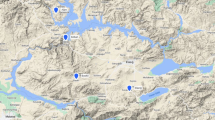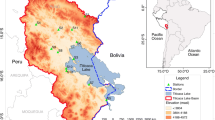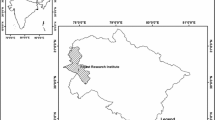Abstract
The Penman–Monteith equation (PM) is widely recommended because of its detailed theoretical base. This method is recommended by FAO as the sole method to calculate reference evapotranspiration (ETo) and for evaluating other methods. However, the detailed climatological data required by the Penman–Monteith equation are not often available especially in developing nations. Hargreaves equation (HG) has been successfully used in some locations for estimating ETo where sufficient data were not available to use PM method. The HG equation requires only maximum and minimum air temperature data that are usually available at most weather stations worldwide. Another method used to estimate ETo is the artificial neural network (ANN). Artificial neural networks (ANNs) are effective tools to model nonlinear systems and require fewer inputs. The objective of this study was to compare HG and ANN methods for estimating ETo only on the basis of the temperature data. The 12 weather stations selected for this study are located in Khuzestan plain (southwest of Iran). The HG method mostly underestimated or overestimated ETo obtained by the PM method. The ANN method predicted ETo better than HG method at all sites.





Similar content being viewed by others
References
Allen RG (1996) Assessing integrity of weather data for reference evapotranspiration estimation. J Irrig Drain Eng 122(2):97–106
Allen RG, Pereira LS, Raes D, Smith M (1998) Crop evapotranspiration. Guidelines for computing crop water requirements. Irrigation and Drainage Paper No. 56, FAO, Rome
Atkinson PM, Tatnall ARL (1997) Introduction neural networks in remote sensing. Int J Remote Sens 18:699–709
Coulibaly P, Anctil F, Bobee B (2000) Daily reservoir inflow forecasting using artificial neural networks with stopped training approach. J Hydrol 230(3–4):244–257
Cybenko G (1989) Approximation by superposition of a sigmoidal function. Math Control Signals Syst 2:303–314
Di Stefano CV, Ferro V (1977) Estimation of evapotranspiration by Hargreaves formula and remotely sensed data in semi-arid Mediterranean areas. J Agric Eng Res 68:189–199
Droogers P, Allen RG (2002) Estimating reference evapotranspiration under inaccurate data conditions. Irrig Drain Syst 16:33–45
Gavilan P, Lorite IJ, Tornero S, Berengena J (2006) Regional calibration of Hargreaves equation for estimating reference ET in a semiarid environment. Agric Water Manage 81:257–281
Hagan MT, Menhaj MB (1994) Training feedforward networks with the Marquardt algorithm. IEEE Trans Neural Netw 5:989–993
Hargreaves GH, Allen RG (2003) History and evaluation of Hargreaves evapotranspiration equation. J Irrig Drain Eng 129(1):53–63
Hargreaves GH, Samani ZA (1985) Reference crop evapotranspiration from temperature. Appl Eng Agric 1(2):96–99
Hargreaves LG, Hargreaves GH, Riley JP (1985) Irrigation water requirements for Senegal River Basin. J Irrig Drain Eng 111(3):265–275
Hornik K, Stinchcombe M, White H (1989) Multilayer feedforward networks are universal approximators. Neural Netw 2:359–366
Irmak S, Allen RG, Whitty EB (2003) Daily grass and alfalfa-reference evapotranspiration estimates and alfalfa-to-grass evapotranspiration ratios in Florida. J Irrig Drain Eng 129(5):360–370
Kumar M, Raghuwanshi NS, Singh R, Wallender WW, Pruitt WO (2002) Estimating evapotranspiration using artificial neural network. J Irrig Drain Eng 128(4):224–233
Lippmann RP (1987) An introduction to computing with neural nets. IEEE ASSP Mag 4:4–22
Meyer SJ, Hubbard KG, Wilhite DA (1989) Estimating potential evapotranspiration: The effect of random and systematic errors, agricultural and forest meteorology, vol 46. Elsevier, Amsterdam, pp 285–296
Odhiambo LO, Yoder RE, Hines JW (2001) Optimization of fuzzy evapotranspiration model through neural training with input–output examples. Trans ASAE 44(6):1625–1633
Prechelt L (1998) Automatic early stopping using cross validation: quantifying the criteria. Neural Netw 11:761–767
Sarle WS (1995) Stopped training and other remedies for overfitting. In: Proceedings of the 27th symposium on the interface of computing science statistics
Silva AF (2002) Previsão da evapotranspiração de referência utilizando redes neurais. Dissertação de Mestrado, Univ. Federal de Viçosa, Viçosa, Minas Gerais, Brazil
Sudheer KP, Gosain AK, Ramasastri KS (2003) Estimating actual evapotranspiration from limited climatic data using neural computing technique. J Irrig Drain Eng 129(3):214–218
Tan Y, Van Cauwenberghe A (1999) Neural-network-based d-step-ahead predictors for nonlinear systems with time delay. Eng Appl Artif Intell 12:21–25
Trajkovic S, Todorovic B, Stankovic M (2003) Forecasting of reference evapotranspiration by artificial neural networks. J Irrig Drain Eng 129(6):454–457
Utset A, Farre I, Martinez-Cob A, Cavero J (2004) Comparing Penman–Monteith and Priestley–Taylor approaches as referenceevapotranspiration inputs for modeling maize wateruse under Mediterranean conditions. Agric Water Manage 66(3):205–219
Zanetti SS, Sousa EF, Oliveira VPS, Almeida FT, Bernard S (2007) Estimating evapotranspiration using artificial neural network and minimum climatological data. J Irrig Drain Eng 133(2):83–89
Acknowledgments
The author would like to express his sincere gratitude to the Department of Irrigation and Drainage Engineering, University collage of Aboureyhan and University of Tehran. The research described in this paper was supported with funds provided by University of Tehran.
Author information
Authors and Affiliations
Corresponding author
Additional information
Communicated by J. Ayars.
Rights and permissions
About this article
Cite this article
Rahimi Khoob, A. Comparative study of Hargreaves’s and artificial neural network’s methodologies in estimating reference evapotranspiration in a semiarid environment. Irrig Sci 26, 253–259 (2008). https://doi.org/10.1007/s00271-007-0090-z
Received:
Accepted:
Published:
Issue Date:
DOI: https://doi.org/10.1007/s00271-007-0090-z




